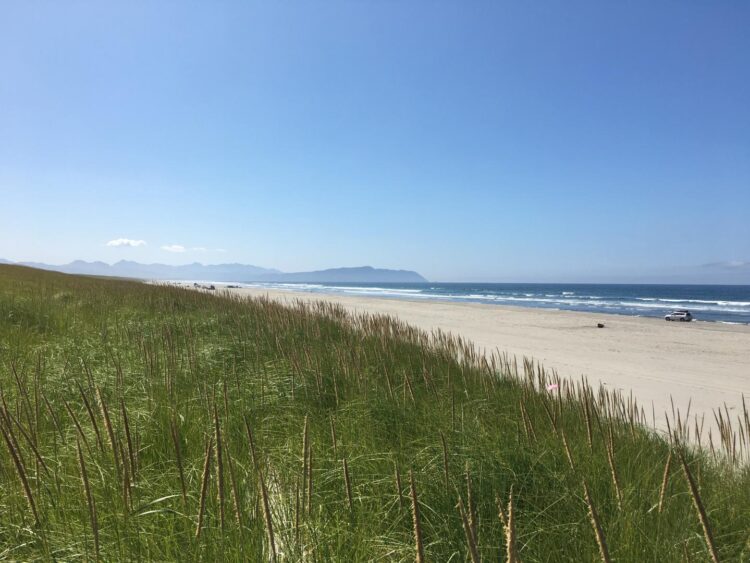
Credit: Oregon State University
CORVALLIS, Ore. – Two species of sand-stabilizing beachgrasses introduced to the Pacific Northwest starting in the early 1900s are hybridizing, raising new questions about impacts to the coastal ecosystems the non-native plants have been engineering for more than a century.
Researchers in the Oregon State University College of Science identified the hybrid in a paper published in Ecosphere.
In addition to their ecological implications, the findings are important in the context of coastal vulnerability to the effects of climate change, including increasing danger from flooding and erosion from storms and rising water.
An OSU collaboration led by integrative biology Ph.D. candidate Rebecca Mostow and professor Sally Hacker employed multiple analytical techniques to show that the beachgrasses that dominate the Northwest’s dunes, Ammophila arenaria and A. breviligulata, have hybridized.
A. arenaria is a European species and A. breviligulata an American species. Scientists say the hybrid’s traits fall between its parent species in many ways, but the hybrid is taller, which is particularly important because shoot height is an indicator of dune-building potential.
“Understanding the ecological and population genetic consequences of the hybridization is critical in a system where any change in dominant beachgrass species can have large effects on both biodiversity management and coastal protection,” Hacker said.
Dunes comprise nearly half of the combined coastline of Oregon and Washington and a quarter of California’s. Starting in the early 20th century, the intentional planting of Ammophila beachgrasses has been used as a tool to stabilize an otherwise shifting sand environment.
Beachgrasses grow in stiff, rugged clumps capable of reaching 4 feet tall. Their strong rhizome mat – the mass of underground stems – helps stabilize the sand and allows for fast colonization. These clumps are able to capture sand and build dunes at rates of up to 3 feet per year.
“By the 1950s, Ammophila arenaria had spread from Mexico to Canada while building tall, continuous coastal foredunes,” Mostow said. “Midway through that spread, in the 1930s, Ammophila breviligulata was planted in dunes near the Columbia River. Over the next 50 years, it moved north and dominated the sandy Washington coast. And there’s no doubt the spread of these beachgrasses has had a positive impact on development by stabilizing the ground and building dunes that protect the coastline.”
As with many introduced species, though, the beachgrasses come with ecological costs to the native flora and fauna. Resistant to pests and grazing, the hardy, densely growing plants have changed the ecology of dunes by displacing native plants and animals, including pink sand verbena and the endangered western snowy plover.
The OSU researchers say the hybrid of A. arenaria and A. breviligulata has been found at a total of 12 locations in Washington and Oregon. Plant morphology – what they look like and how they are put together – are consistent with hybridization, and genotyping and genome-size comparisons show the hybrid is a first-generation blend of the two introduced beachgrasses whose ranges overlap.
“Novel hybrid zones are an ecologically important upshot of species introductions and invasions,” Mostow said. “Hybridization between different species can lead to gene flow between parent species or produce novel taxa that can alter invasion dynamics or ecosystem services. As far as we know, the Pacific Northwest is the only place in the world where the two Ammophila species have had the opportunity to hybridize.”
A. breviligulata, Hacker notes, is better than A. arenaria at establishing its place in an ecosystem – it competes better – but A. arenaria builds taller dunes. The strengths and weaknesses trace to differences in grass density, morphology and growth form and their effects on sand capture.
“If the hybrid exceeds its parents in traits associated with dune-building, which it very possibly could, then its spread could affect dune shape and size and have huge, ecosystem-scale consequences,” she said. “Hybridization could end up resulting in a really invasive taxon or increasing the invasive potential of either parent species.”
###
Also collaborating on this research was Felipe Barreto, assistant professor in the OSU College of Science.
The study was supported by Oregon Sea Grant, the National Science Foundation and the Washington Native Plant Society.
Ongoing research includes a citizen science component in which beachgoers are invited to look for and photograph specimens of the hybrid. Details are available at iNaturalist.
Media Contact
Sally Hacker
[email protected]
Original Source
https:/
Related Journal Article
http://dx.





